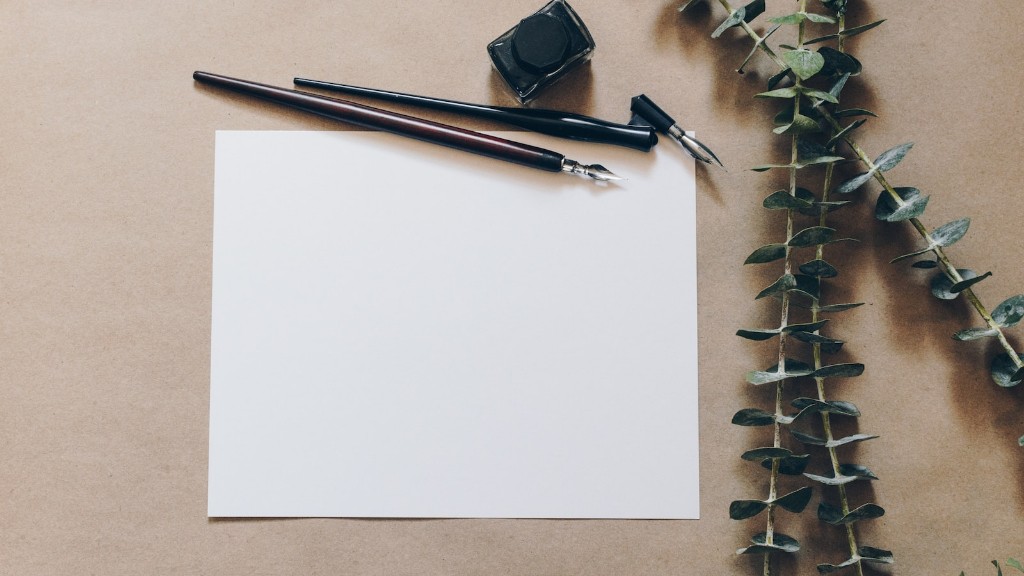Why is Letter Paper Thicker
Letter paper is thicker than standard copy paper, and the reasons for this are varied. For starters, the extra thickness provides a better writing surface – an important consideration for letters sent between businesses and individuals.
In addition, letter paper is designed to stand out from other paper products: it has a richer, heavier texture and more of a substantial feel than regular paper, providing a sense of gravitas. Above all else, letter paper is intended to make an impression, and its distinctive texture helps the letter to catch the eye of its recipient.
There are also practical reasons why letter paper comes in different weights. In many cases, the weight of the paper used can be a decisive factor when it comes to its ability to survive the rigors of the mail system. Letter paper is usually more durable, and so its sturdiness can make it a better choice where thick paper is necessary in order to avoid damage in transit.
How Thick is Letter Printer Paper
One of the biggest differences between letter paper and standard paper is its thickness. The standard measurement of paper thickness is in points, with one point equal to 0.001 of an inch. Letter paper is typically 70–90 points thick, while standard paper is usually 50–60 points thick. That means that letter paper is roughly 20-50% thicker than regular copy paper.
This extra thickness can be beneficial in a few ways. For one thing, letter paper can offer a smoother writing surface than standard paper. Additionally, it can be more resistant to damage in transit, which is obviously an important consideration by mail.
How Letter Printer Paper is Installed and Used
Letter printer paper comes in several different formats, but it always starts with high-quality paper that’s designed for laser, ink-jet, or dot matrix printers.
The best way to install and use letter paper is to start by selecting a type that suits the particular printer. Many printers are equipped to automatically feed and print on letter-sized paper, and the type of paper that’s compatible with a given printer will be indicated in the user manual.
Once the proper paper for the printer has been sourced, it should be loaded into the printer’s paper tray before the desired letter is printed. After printing the letter, some type of post-processing may be required, such as folding or sealing envelopes.
How Letter Printer Paper is Sourced
When it comes to sourcing letter printer paper, most businesses and individuals simply purchase it from a retailer or office supply store. Some businesses may buy custom stationery with their company logo and name printed on it.
That said, some printers have the capability to print on heavy cardstock, which could serve as an alternative to letter paper. Cardstock is heavier and thicker than letter paper, but it’s also more expensive. In some cases, companies might opt for cardstock if they’re looking for a premium look and feel for their stationery.
How to Manage Environmental Impact of Letter Printer Paper
When letter printer paper is used, it’s wise to consider the environmental impacts of its production and disposal. When selecting the right type of paper, it’s important to consider the amount of wood fiber used and the kind of chemicals and inks that may be used in the production process.
In terms of disposal, envelopes and cardstock should generally be recycled when possible, as opposed to discarded as trash. Other measures, such as using recycled paper and printing on both sides of the paper, can help to reduce the amount of paper waste generated.
Innovations in Letter Printer Paper
Over the past several years, there have been a variety of new innovations in the letter printer paper industry. One of the most notable is the advent of digital printing systems, which allow companies to print on demand without having to go through the process of stocking and managing large inventories of paper.
Another major development has been the use of specialty papers and envelopes. For instance, self-sealing envelopes are becoming increasingly popular, as they don’t require the use of glue or tape to seal. Similarly, water-resistant papers are now available, which can be useful for print jobs that may need to withstand water or moisture.
Uses of Letter Printer Paper in Communication
Letter paper has long been used as a medium for communication, ranging from personal mail to business correspondence. Crucially, it allows for a sense of formality and professionalism to be conveyed in a way that plain paper simply cannot.
The distinctive appearance of letter paper is particularly useful for businesses, as it allows them to distinguish themselves from competitors. In addition, the extra thickness and quality of letter paper can help to deliver messages of importance to the recipient, such as anticipation of a response, urgency, or emphasis.
Using Letter Printer Paper for Branding
These days, most businesses recognize the value of using letter paper to promote their brand. Letter paper can be printed with a company’s logo and other branding elements, creating an eye-catching design that helps the business to stand out from the competition.
Moreover, business owners can use letter paper to make a good impression with clients and customers. Since the paper is a premium quality, it can help lend a professional air to the company’s materials and communications. Furthermore, the use of letter paper can subtly communicate to customers that the company is serious and reliable.
Advantages of Letter Printer Paper Over Email
In the digital age, it’s often easier and more efficient to communicate via email. However, nothing says “special” quite like a handwritten letter on quality letter paper.
For one thing, physical letters can be more easily used for marketing and advertising purposes. For example, businesses can include a promotional coupon or flyer along with a handwritten letter that’s printed on high-quality letter paper. Such a presentation can be more effective than an email, and it can influence the recipient’s perception of the company in a positive way.
Furthermore, physical letters are more personal and tangible than emails. They offer a sense of permanence that an email message simply doesn’t have, and they can convey warmth and sincerity that’s lost in a digital medium.
Uses of Letter Printer Paper in Education
Letter paper is also an essential element of formal education. Mostly speaking, it’s used in academic contexts by students to submit assignments to their teachers or professors.
The following are a few popular uses of letter paper in an educational setting:
• Cover letters – Students may submit cover letters along with resumes when applying for positions.
• Theses and dissertations – Higher-level research papers may call for the use of letter paper.
• Correspondence – Many educational institutions require students to communicate with professionals and teachers through letters.
• Accommodation letters – Students may submit letters to secure accommodation or other services.
• Statement of purpose – Graduate and post-graduate students will often have to submit a statement of purpose printed on letter paper.
Using Letter Printer Paper to Create a Lasting Impression
In many cases, letter paper is used when an impression needs to be made. For instance, sending a physical letter to a prospective employer can help to make a good first impression, and similarly, sending letters of thanks or appreciation on quality letter paper can have a positive effect on the recipient.
Overall, letter paper is a great way to make a lasting impression and is designed to accomplish this very purpose. Its weight, texture, and overall presence make it ideal for applications where making a lasting impression is paramount.


